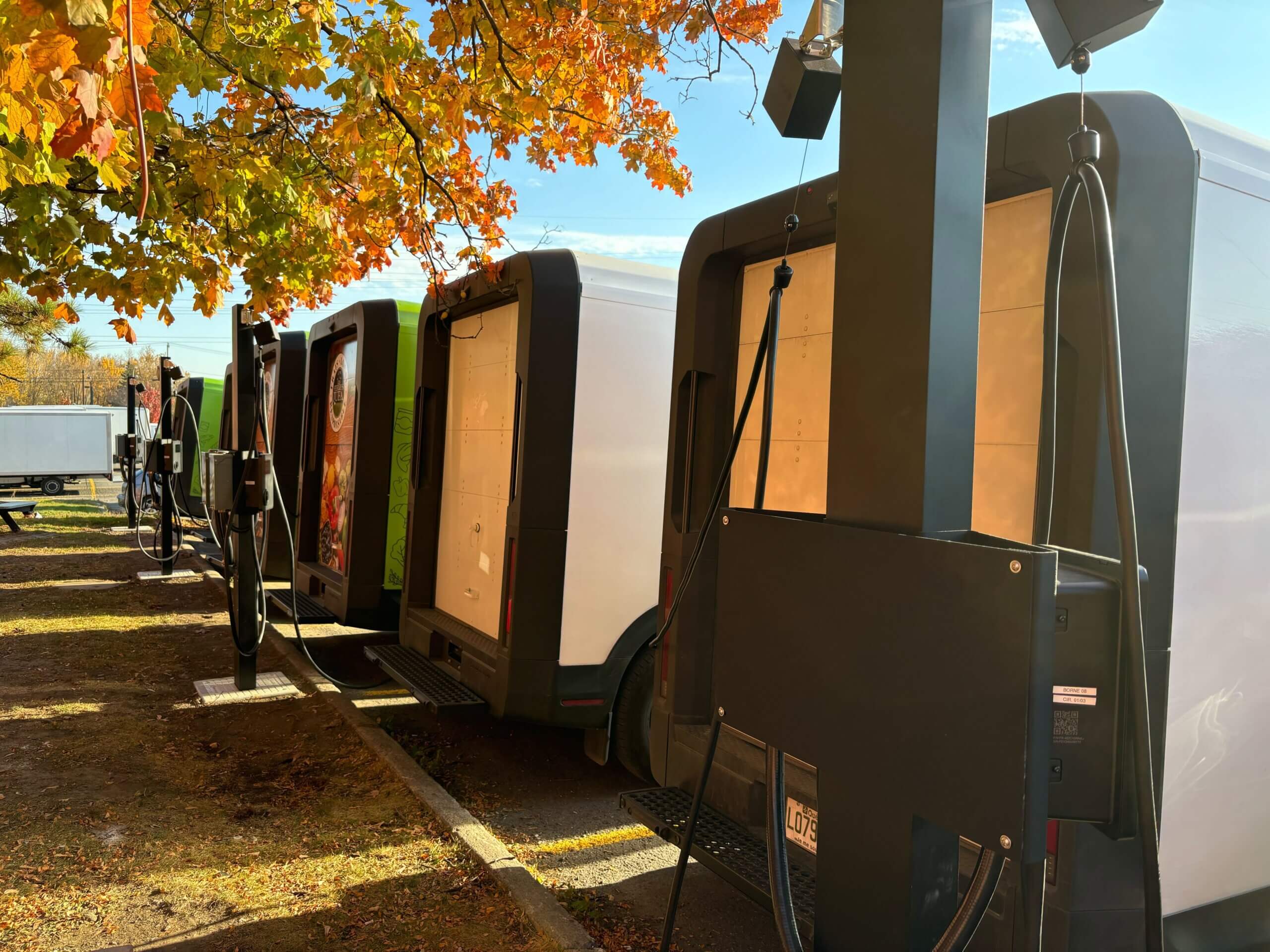In an era where sustainability isn’t just a buzzword but a business imperative, operators and fleet managers will be happy to know that switching to sustainable last-mile delivery doesn’t have to bottom out your pockets, or break your budget.
In fact, it’s a smart move that will cut costs, boost efficiency, increase driver satisfaction, and capture the attention of shippers and consumers looking for lower-emissions deliveries. Investing in sustainability isn’t just about compliance, it’s about deploying the vehicles today that will be essential to winning business in the future.
The challenges of last mile delivery
Last mile delivery—transporting goods from a local hub or fulfillment center to a final destination— is the most expensive and environmentally impactful segment of the logistics chain. Last mile deliveries account for more than 50% of total shipping costs and contribute significantly to urban congestion and pollution annually.
On one side of the coin, there is growing demand for fast delivery options, such as same-day or 2-day shipping, which contributes to the frequency and challenges of last-mile delivery. On the other side, customers increasingly care about how their deliveries affect the environment, with 60% preferring companies with lower carbon footprints.
For fleet managers, this means sustainability isn’t just “nice to have”—it’s a competitive advantage.
The future of last mile delivery is electric
With benefits like lower operational costs, advanced technology, improved air quality in neighbourhoods, and compliance with government regulations (Canada | United States), electric delivery vehicles offer a clear competitive edge. They not only reduce emissions, but also help fleet managers cut costs and improve efficiency, making them an ideal choice for the future of last mile delivery.
1. Lower transportation costs
While upfront costs are higher than traditional diesel vehicles, the long-term savings are undeniable.
Fuel, maintenance, and inefficient routes are some of the biggest cost drivers for last mile delivery fleets. Yet, electric vehicles cost less to maintain compared to traditional internal combustion engine vehicles—no oil changes, fewer moving parts, and longer-lasting brakes.
And, when you consider that electricity prices are far more stable compared to fossil fuels, fleet managers that choose to go electric get to take advantage of predictable operating costs, making it easier to plan, budget, and use resources effectively.
Finally, with better battery technology, including innovations like regenerative braking and quieter vehicles supporting deliveries even after noise bylaw hours, the cost per mile for EVs is getting more attractive, especially for the short distances and frequent stops typical of last mile delivery.
A Total Cost of Ownership (TCO) analysis reveals that while electric vehicles may have a higher initial cost, the long-term savings in maintenance and energy expenses make them a smart investment.
Fleet managers can leverage government incentives, tax credits, and grants to offset the initial costs of fleet electrification. Better yet, with a lease-to-own model like 7Gen’s, in many regions customers are paying a monthly vehicle lease fee that amounts to less than what they are spending on ICE van fuel and maintenance per month now.
2. Better operational efficiency
EV adoption isn’t just about swapping diesel for electric—it’s about optimizing your fleet and energy consumption. Unified reporting dashboards offered by 7Gen centralize vehicle, charger, and utility data, enabling fleet managers to:
- Monitor energy consumption to reduce electricity costs.
- Track real-time emissions data and benefit financially from carbon credit accruals where eligible.
- Access telematics and analytics to streamline delivery routes and reduce mileage.
These technology-driven insights allow fleet managers to make data-backed decisions that improve operations and reduce your environmental impact. Further, this data is valued by shippers who need to report on their Scope 3 emissions. Being able to accurately report on GHGs avoided supports business development opportunities with these retailers.
3. Zero emission last mile solutions for regulatory compliance
Governments all over the world are setting stricter emissions standards based on the Paris Climate Agreement, especially in cities where air quality is a growing concern. And rightly so when you consider that the transportation sector emits 1.9 billion tons of CO2 annually. To put that in plain terms, in cities, the majority of people live and work within 300 meters of major thoroughfares, where air quality can be up to 300% worse than in parts of the city with less traffic.
Switching to zero emission last mile solutions not only helps fleets meet these evolving regulations, but also reduces their carbon footprint. Electric last mile delivery vehicles emit no tailpipe emissions, making them preferred for urban routes and resulting in improved air quality for cities.
4. Building a sustainable advantage
Investing in sustainable last-mile delivery isn’t just about compliance or cost savings—it’s a competitive differentiator. Consumers today care more and more about sustainability, and they want to support companies that do too.
In fact, 43% of consumers are more likely to choose retailers that offer more sustainable delivery options, showcasing that shippers and consumers are increasingly seeking and choosing the more sustainably last mile delivery option where available.
By putting sustainability at the forefront, it can help win contracts with large e-commerce retailers and logistics providers with a focus on Environmental, Social, and Governance (ESG) criteria. And, considering that one third of shipping RFPs are requesting EV services, it pays to make the switch.
Overcoming barriers to zero-emission vehicles
Despite the benefits, many fleet managers are hesitant to adopt EVs due to concerns about range, infrastructure, and cost. However, these myths are easily debunked:
- Range anxiety: Advances in battery technology now enable EVs to cover 200+ miles on a single charge, making them perfect for most urban and suburban routes.
- Charging infrastructure: Whether you are looking to build your own charging infrastructure or partner with local providers, there are a ton of options to make sure your fleet is at the ready. It’s good to note that if you own your own charging, it is often more cost-effective than external charging.
Fully managed solutions, like those offered by 7Gen, handle everything from installation to ongoing maintenance and optimizing software. Learn more.
- Upfront costs: Flexible financing options, such as lease-to-own models, convert CAPEX into manageable monthly OPEX, making EV adoption accessible even for budget-constrained fleets.
Plus, savvy fleet managers can access a range of available regional and federal incentives. Many governments offer rebates, grants, and tax credits to help reduce the upfront costs of fleet electrification. These incentives can make the transition to electric vehicles more accessible for budget-constrained fleets.
Steps to transition to sustainable last-mile delivery
Fleet managers looking to embrace sustainable last-mile solutions can follow these key steps:
- Partner with experts: Collaborate with providers like 7Gen to accelerate your transition. Recommendations will be tailored to your region, payload requirements, and budget.
- Assess your current fleet: Evaluate which vehicles are ready for replacement, identify the right EV for your operations and calculate your savings with a TCO analysis.
- Identify available incentives: Research local rebates, grants, and tax credits to offset initial costs.
- Install charging solutions: Ensure infrastructure readiness with comprehensive site assessments and charger leasing options.
- Monitor and optimize: Use fleet management software to track performance metrics and identify areas for improvement.
Talk to our experts to get you going with sustainable last mile delivery EVs and charging infrastructure/
The road ahead for last-mile delivery
Switching to sustainable last mile delivery isn’t just about compliance—it’s a powerful way to cut costs, reduce emissions, and gain a competitive edge in an ever competitive market.
7Gen’s comprehensive solutions take the guesswork out of transitioning to EVs. From vehicle selection to charging setup and financial planning and operations, we’ll guide you every step of the way.
Ready to electrify your last mile delivery fleet? Reach out today to see how we can support you.




